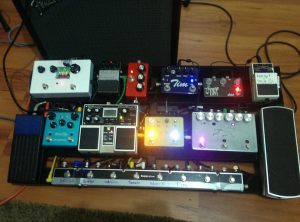When is cheap too cheap? This is a question I never seem to ask myself. If it’s cheap and it serves it’s purpose then it’s good enough for me. However in this pedals case you do indeed get what you pay for. Like always I must inform you readers that this pedal I bought with my own funds.
Plastic, Plastic and More Plastic
Most budget pedals aren’t made with durability in mind and the build quality of such pedals suggest a “throw away” life span. The plastic enclosure with the Daphon seem to be quite rugged and durable. The enclosure is made of smooth matt plastic and is quite thick to boot. Audio and power jacks are flush fit and adds a nice neat finish to the pedal. The foot switch is reminiscent of a Boss pedal and just like Boss pedals a plastic shaft presses a PCB mounted tactile switch. Lifting the pedal reveals some heft and feels a bit thicker compared to other plastic enclosed pedals. Would I throw this thing at a brick wall and expect it to be in one piece? Probably not. Would I stomp on this thing with steel capped boots and expect it to come out unscathed? Most likely. If you’ve been paying attention to the history of guitar pedals these pedals look like a cheaper version of Ibanez’s Soundtank series and if you’re assuming that Daphon used to make Ibanez pedals you would probably be correct.
You Truly Get What You Pay For
Daphon Super Overdrive. Yes. This pedal is a Boss SD-1 clone. Any Boss SD-1 mods you can find will also work for the E10D. For the price you pay you do get a lot of pedal. 3 Knobs control the volume, tone and drive. With the volume cranked and the gain set to zero you get a clean boost. Adding in gain produces an open crunchy overdrive. Having the gain set between 6-12 o’clock is probably the best way to have it set. Anything above that and the gain structure sounds pretty much the same. I think this is due to the fact that all the potentiometers used in the pedal are logarithmic based. This basically means that you get large increments at the start of the rotation and barely anything at the last few degress which is pretty annoying if you’re trying to set tone.
There seems to be a bit of a mid hump when you active the overdrive. Seeing the pedal is advertised as “transparent” removing all the gain shows that this isn’t the case. Diming the tone knob brings in a very harsh treble tone. Very piercing and in my opinion pretty unusable unless you really feel the need to cut through. Pulling the tone back adds a bit of bass but not enough to help the mid-hump. Optimal settings for this pedal for me was having the volume at unity, the tone at 11 o’clock and gain set around 9 oclock. Stack ability? It works pretty well. E10OD going into a Fab Overdrive (review here) at my optimal settings added extra saturation and crunch without ever going too muddy. Plugging into a DS-1 however dug up some unsuspecting gold. With the E10OD’s volume cranked, the tone completely dimed an the gain taken out the pedal pushed the DS-1 into further saturation and added a bit more high end. Perfect for when you need to push a lead line. Speaking of stacking pedals, the buffer on this thing sucks. Literally. You start to lose a lot of high end as soon as you start to add more buffered pedals and I’m pretty sure even with just this on its own you lose a bit of tone.
Final Verdict
Whilst not totally unusable you do need to watch how much far you’ve cranked the tone and gain knob because you’ll find that the pedal quickly turns into quite a mess. Being a straight up Boss SD-1 clone you have a great base to start modding into a super charged SD-1 or with a few component changes you can have a TS808. If you had little to spend on a pedal and it was going to be your go to overdrive I probably wouldn’t go for the E10OD. However if you love tinkering and you’re pretty handy with a soldering iron this would probably be for you.
Pros:
+ Sturdy plastic build
+ Budget Boss SD-1
Cons:
– Pronounced Mid Hump
– Overdrive can get a bit samey and muddy past 12 o’clock
– Unusable high-end
– Sucky buffer circuit
Timothy











